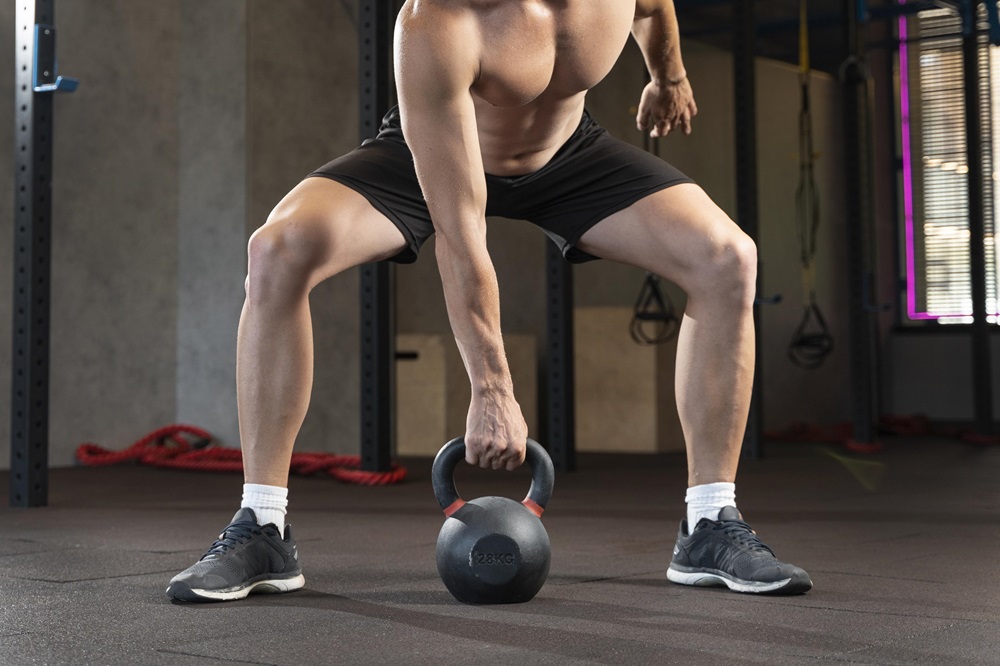Kettlebell Training – Effects, Principles, Exercises

Kettlebell training consists of exercises performed with the use of round weights that can improve muscular strength and endurance, as well as coordination and body shape. These workouts are practiced worldwide by both beginners and experienced bodybuilders. What are the rules of kettlebell training? Kettlebell training effects - is it worth it? Which kettlebell exercises should be included in a workout plan?
Table of contents
- What is a kettlebell? A brief history
- Types of kettlebells - which one to choose?
- Kettlebell training - why is it worth it?
- Kettlebell training for beginners
- Kettlebell exercises for abs
- Kettlebell exercises for glutes
- Kettlebell exercises for chest
- Kettlebell exercises for biceps
- Sample kettlebell workout plan
What is a kettlebell? A brief history
A kettlebell is a cast-iron or steel training tool whose history dates back to ancient Greece – historical sources suggest that objects resembling today’s kettlebells were already used in preparation for the first Olympic Games.
Modern kettlebells, also known as “girya,” originate from Russia, with the first written mention dating to 1704.
Initially, kettlebells served as counterweights among Russian peasants. They appeared at fairs and festivals, later becoming part of strength demonstrations. In 1880, Dr. Vladislav Kraevsky promoted them as training equipment for the Russian Army, and by 1940, kettlebell lifting had become the USSR’s national sport.
In the West, kettlebells appeared only in the early 21st century, likely introduced by a Belarusian trainer who emigrated to the United States to train members of the US Marine Corps. In the US, kettlebells quickly gained popularity among bodybuilders and strength sports enthusiasts, and soon after, kettlebell training spread globally.
Types of kettlebells - which one to choose?
Kettlebells are an excellent tool for strength training, available in several types:
- composite
- vinyl
- cast iron
- bitumen
- rubber-coated cast iron
The most commonly used are rubber-coated and vinyl-coated kettlebells, which are durable and protect the floor from damage.
When choosing a kettlebell, pay attention to the shape, quality of craftsmanship, and the size of the handle – it should be large enough to hold comfortably with both hands.
Kettlebell training - why is it worth it?
A kettlebell is a versatile tool that allows for training almost every body part. Its spherical shape and shifted center of gravity put additional pressure on the muscles, activating more muscle fibers than many other tools. This makes kettlebell workouts more challenging and effective for motor skills, mobility, conditioning, strength endurance, and maximum strength.
Kettlebells are relatively inexpensive, portable, and easy to use both at home and in the gym. The variety of weights available allows you to adjust the load to your fitness level and training goals.
Effects of kettlebell training
Regular kettlebell workouts can improve muscular strength, endurance, grip, and overall conditioning. They also benefit the nervous and circulatory systems.
They enhance balance, coordination, joint mobility, and strengthen muscles, ligaments, and tendons. Kettlebells engage deep muscles, which improves spinal stability and posture, potentially correcting postural defects.
They can boost metabolism, help reduce body fat, and increase calorie burn. The unique movement patterns also make kettlebell exercises a fresh stimulus for the body.
Rules for kettlebell training
Kettlebell training is suitable for beginners, but proper technique and breathing are essential. Pay attention to wrist position – wrists should stay aligned with the hands and forearms without relaxing them to avoid injury.
Because of the shifted center of gravity, kettlebells work differently than dumbbells, requiring adjusted technique.
There are two main kettlebell training styles:
- Hardstyle – few repetitions, high intensity, heavy weights, focusing on maximum muscle tension and minimal rotation to increase strength, speed, and power.
- Girevoy sport – many repetitions, lower intensity, improving endurance and overall performance.
Choose the right weight – one you can lift to shoulder height with both hands without strain. Always involve your hips during movements and keep them engaged.
Perform a warm-up before training and stretching afterward to prevent injuries.
Kettlebell training for beginners
Both men and women can train with kettlebells regardless of experience level. Exercises can target all muscle groups, with the weight adjusted to the user’s ability. Common kettlebell moves include two-handed and one-handed swings, the clean, goblet squats, and presses.
Kettlebell exercises for abs
- Russian twist – sit holding a kettlebell at chest height, lean back, lift your feet off the floor into a balanced position, engage your core, and twist your torso side to side.
- Farmer’s walk – stand upright holding kettlebells at your sides, engage your core, and walk steadily for a set time, then put them down carefully.
Kettlebell exercises for glutes
- Reverse lunges – hold a kettlebell at chest height, step back into a lunge, then return to start. Alternate legs.
- Goblet squat – hold a kettlebell at chest height, feet hip-width apart, engage core and glutes, squat down with straight back, then return to start.
Kettlebell exercises for chest
- Lunge and press – hold a kettlebell on your shoulder with elbow high, perform a lunge, then press the kettlebell overhead before returning to start.
- Half-kneeling press – kneel on one knee, kettlebell on the same-side shoulder, press it overhead, then lower back.
Kettlebell exercises for biceps
- Swing – stand with feet shoulder-width apart, hold the kettlebell with both hands, hinge at the hips, then explosively extend hips to swing it forward.
- One-arm snatch – hinge at the hips, lift the kettlebell explosively from the floor to overhead in one motion, then return to start.
Sample kettlebell workout plan
5-minute full-body warm-up
Main workout:
- Swing – 3×10
- Clean – 3×10
- Farmer’s walk – 3×10 sec
- Goblet squat – 3×8
- Reverse lunge – 3×12
5-minute full-body stretching

